Sunday, January 29, 2006
Thursday, January 26, 2006
Pineapple Research Institute
Renowned pineapple geneticist (and former PRI director) J.L. Collins wrote in 1960: "The most complete collection of pineapple species and varieties is the one maintained in Hawaii by the Pineapple Research Institute. This collection constitutes a living herbarium of pineapple types and a reservoir of pineapple genotypes and germ-plasm. It has been developed by private enterprise and the material is not available for general distribution." J.L. Collins, The Pineapple: Botany, Cultivation & Utilization (1st ed. 1960).
According to Chan et al., one of the main objectives of the PRI was to develop an improved variety of the Smooth Cayenne, but no such variety was ever successfully developed. Chan et al., at 33. (However, the Gold pineapple, mentioned below, would appear to be such an improved variety.) The PRI closed in 1975 and "a small number of the PRI varieties and genetic collection were turned over to the US Department of Agriculture (USDA) germplasm repository in 1986." Id. at 34. The old PRI grounds are now occupied by an intergenerational education center.
The USDA Agricultural Research Service (ARS) has recently published an excellent article about its pineapple collection in Hilo, Hawaii, which presumably contains the PRI varieties mentioned above. The pineapple collection is officially part of the ARS National Clonal Germplasm Repository for Tropical and Subtropical Fruit and Nut Crops.
The ARS collection includes nearly 200 pineapples and related plants. Of particular note are the Cheese Pine, which may be the sweetest pineapple in the collection with the highest vitamin C content, and the Saigon Red, an ornamental miniature pineapple that is sometimes only 5 inches tall when fully grown. (Update: In response to an inquiry by the Pineapple Blog, ARS officials have explained that it is the fruit of the Saigon Red that is sometimes only 5 inches tall, not the entire plant.)
The ARS reports that it is currently pursuing a new pineapple genetic fingerprinting initiative, which uses a more sensitive technology, amplified fragment length polymorphism (AFLP). With AFLP, researchers have found clear genetic differences between the wild red pineapple (Ananas comosus var. bracteatus) and other pineapples in the collection. A principal aim of the fingerprinting initiative is to preserve the pineapple's genetic diversity, crucial to disease and pest resistance.
(Click here for another account of the dissolution of the PRI. Click here for an article about an intellectual property dispute between Del Monte Fresh Produce and the Maui Pineapple Co. regarding the Gold pineapple, which was developed at the PRI.)
(This post has been updated.)
Wednesday, January 25, 2006
Comments on Taiwan Pineapple Varieties
In addition to alluring names (Tainung No. 13, the "Winter Honey Pineapple") and unique characteristics (Tainung No. 4, the pineapple you can peel with your bare hands!), the Taiwan varieties are remarkable for their translucency. The Fu-Mu Cayenne and, based on COA photos, Tainung Nos. 13, 17, 18 and 19 all have fairly translucent flesh. In contrast, pineapples that are widely available in the U.S. generally are much less translucent. Translucency appears to be regarded as a defect in the U.S. pineapple industry (and in Australia, as well). Translucent fruit, among other things, is reportedly more susceptible to impact injuries.
Click here for a COA page (in English) on Taiwan's pineapple industry.
Sunday, January 22, 2006
Taiwan Pineapple Varieties
The following is a translation, prepared by the Pineapple Blog, of a description of Taiwan's current commercial pineapple varieties. It -- together with the included photos -- is part of an on-line knowledge database maintained by the Taiwan Council of Agriculture (COA).
(Note: The term "tainung" means "Taiwan variety." The months specified after each entry appear to indicate the variety's seasonal availability.)
Pineapples
Taiwan produces many commercial varieties of pineapples. Current edible varieties include the Fu-Mu Cayenne and Tainung Nos. 4, 6, 11, 13, and 16-20.
I. Fu-Mu Cayenne 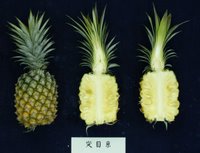
Commonly known as “No. 1” or “Fu-Mu” ("puffy eye"). It is a natural mutation of the Cayenne pineapple. The plant is smaller than the standard Cayenne; its leaves are narrow and spineless. The fruit is of short cylindrical shape, with slightly bulging fruitlets. It has a high percentage (~ more than 70%) of edible flesh. The flesh is translucent and golden. The average fruit weight is 1.3 kg, and is great for fresh eating. One drawback, however, is that the fruit tends to have multiple crowns (a cockscomb formation). May-June.
II. Tainung No. 4 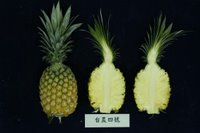
Commonly known as the “Cherimoya Pineapple.” It is also known as the “Easy Peeler” because it can be eaten by cutting the pineapple in half or into quarters, then pulling apart the fruitlets one by one, without having to peel. The plant is small and its leaves are spiny. The fruit is of cylindrical shape, except that fruits produced in early spring are usually pyramid- or cone-shaped. Tainung No. 4 has bulging fruitlets. The flesh is dense, with little fiber, and very fragrant. It is not very juicy. Sugar content is 19.5°Brix. Acidity is about 0.43%, and sugar-acid ratio is 45. The average fruit weight is 1.2 kg. Because it stores well and transports well, it used to be one of Taiwan’s main export fruits. March-May.
III. Tainung No. 6 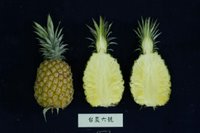
Because of its apple fragrance, Tainung No. 6 is commonly known as the “Apple Pineapple.” The leaves are green with a touch of red and are spiny. The fruit is cylindrical or ball shaped. Thin skinned. The flesh has a fine texture, delicate, crisp, and juicy. Sugar content is about 15.1°Brix. Acidity is about 0.34%, and sugar-acid ratio is 44. Excellent aroma. The average fruit weight is 1.3 kg. This is very popular in the fresh fruit market. April-May.
IV. Tainung No. 11 
Commonly known as the “Perfume Pineapple” because of its distinct fragrance. The plant is medium-sized. The leaves are erect and spineless. The fruit is cylindrical. The fruitlets are slightly bulging. The flesh has a fine texture and is juicy. Somewhat acidic. Sugar content is about 14.8°Brix. Acidity is about 0.57%. Sugar-acid ration is 26. The average fruit weight is 1.0 kg. The fruit stores well and transports well. It is very popular in the Japanese fresh fruit market. May-June.
V. Tainung No. 13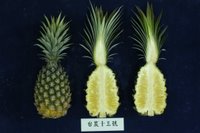
Commercially known as the “Winter Honey Pineapple.” The plant is tall. The leaves are long and erect, often with little spines near the tip and the base. The leaves are grass green, with a purple-red streak down the middle. The fruit is slightly cone shaped. The fruitlets are slightly bulging. The flesh is golden and somewhat fibrous (and thus the fruit is also known as the “Sugarcane Pineapple”). Sugar content is about 15.7°Brix. Acidity is about 0.27%. Sugar-acid ration is 58.1. Has a strong pineapple fragrance. The average fruit weight is 1.2 kg. Normal season is late June to mid July, but it can be induced to fruit any time of year. Therefore, among all the different varieties, Tainung No. 13 is especially suited for autumn/winter production. It can be induced to fruit between August and February when other varieties are not in season.
VI. Tainung No. 16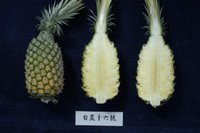
Commercially known as the “Sugar Honey Pineapple.” Other than at the tip, the leaves are spineless. The center of each leaf is light purple-red and ridged. The fruit is elongated cone or football shaped. The fruitlets are slightly bulging. The flesh is extremely delicate, with a fine texture. Sugar content is about 18°Brix. Acidity is about 0.47%. Sugar-acid ratio is 38.3. Excellent aroma. Average fruit weight is 1.3 kg. April-July.
VII. Tainung No. 17 
Commercially known as the “Golden Diamond.” The plant is medium sized. Other than the tip, the leaves are spineless. The leaves are slightly rust colored, green at the ends. The fruit is cylindrical, thin skinned, with shallow flower bracts. The flesh is deep yellow or golden and delicate. The core is relatively large, but tender and edible. Sugar content is about 14.1°Brix. Acidity is about 0.28%. Sugar-acid ratio is 50.4. Taste and aroma are both excellent. The average fruit weight is 1.4 kg. March-May.
VIII. Tainung No. 18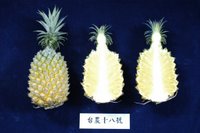
Commercially known as the “Golden Osmanthus.” The plant is small. Spineless. The leaves are green, but the center is slightly dark red. The fruit is cone shaped. The fruitlets are slightly bulging. Thin skinned, with shallow flower bracts. The flesh is yellow or golden, and in the mid-range of fibrousness. Sugar content is about 14.1°Brix. Acidity is about 0.39%. Sugar-acid ratio is 38.7. Has an osmanthus fragrance. The average fruit weight is 1.5 kg. April-July.
IX. Tainung No. 19 
Commercially known as the “Honey Treasure Pineapple.” Small plant. Other than the tip, the leaves are spineless. The leaves are deep green. The fruit is cylindrical, with many small fruitlets. Thin skinned, with shallow flower bracts. The flesh is golden, delicate, and with a fine texture. Sugar content is about 16.7°Brix. Acidity is about 0.46%. Sugar-acid ratio is 37.8. The average fruit weight is 1.6 kg. April-July and Oct.-Nov.
X. Tainung No. 20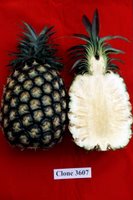
Commercially known as the “Milk” pineapple. Tall, large plant. Spineless. The leaves are deep green. The fruit is cylindrical, with many small fruitlets. Thin skinned, with shallow flower bracts. The flesh is milky white, delicate, and with a fine texture. Very fragrant. The average fruit weight is 1.3 kg. May-Oct.
Wednesday, January 18, 2006
Pineapple Specimen Sources Updated
Monday, January 16, 2006
Pineapple Seeds
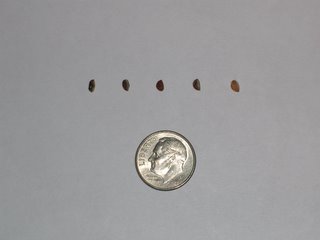 Above is a photo of five pineapple seeds. (The dime is included for scale.) The seeds are from an organic golden pineapple imported from Ecuador.
Above is a photo of five pineapple seeds. (The dime is included for scale.) The seeds are from an organic golden pineapple imported from Ecuador.See this GardenWeb forum thread for more information about pineapple seeds.
Saturday, January 07, 2006
Pineapple Specimen Sources
However, there are many different pineapple varieties. Most grocery stores (at least in the western U.S.) carry the smooth cayenne or the related (and newer) golden variety: yellow flesh, cylindrical, about the size of a football, juicy, smooth leaves with no spines on the edges. The Maui Pineapple Company has posted some information about golden and Champaka (a Cayenne variety) pineapples.
There's nothing wrong with the cayenne, which makes a fine choice for home cultivation. And, a home-grown cayenne is likely to be much superior to (but probably smaller than) a store-bought, because the grower can be sure to allow the fruit to ripen fully before harvesting.
But, one of the best things about home pineapple cultivation is the chance to grow more unusual pineapple varieties. Some sources for non-cayenne pineapple specimens are listed below:
- Fruit Lover's Nursery in Pahoa, Hawaii sells sugarloaf pineapple crowns from June to August. Great crowns, very easy to root.
- Montoso Gardens in Maricao, Puerto Rico sells non-edible nanus pineapple plants. Beautiful, healthy specimen.
- Harry & David, the mail-order fruit company, sells "baby pineapples" (probably the "Z" queen variety), whose crowns can be propagated. Can be difficult to grow successfully.
- baying4u, an ebay merchant in southern California, sells several different varieties of harder-to-find pineapple plants, such as the white perola, Kona sugarloaf and lucidus. Decent, but not perfect, quality plants.
- Florists will sometimes carry cut ornamental variegated pineapples for floral arrangements. Very difficult to propagate successfully.
Purdue University's NewCROP website has an electronic version of Fruits of Warm Climates by Julia F. Morton. This on-line text includes what is probably the most extensive catalog of pineapple variety descriptions publicly available on the web.
(This post has been updated.)
Thursday, January 05, 2006
Growing Pineapples at Home
Several sites provide detailed instructions on home pineapple cultivation. (There's a little more to it than what's set out above.) --
- indoorpineapplegrowers.org (an invaluable resource for home pineapple growers -- Al Nesbit, Jr. is my hero)
- Surrey Pineapples (a meticulously documented account of a home pineapple growing project, many great photos)
- Central Coast NSW Bromeliad Society (short and sweet growing instructions)

